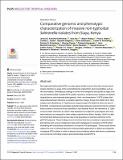Comparative genomic and phenotypic characterization of invasive non-typhoidal Salmonella isolates from Siaya, Kenya

View/
Publication Date
2021Author
Jessica Z. Kubicek-Sutherland , Gary Xie ,Migun Shakya,Priya K. Dighe,Lindsey L. Jacobs,Hajnalka Daligault,Karen Davenport,Loreen R. Stromberg,Zachary R. Stromberg,Qiuying Cheng,Prakasha Kempaiah,John Michael Ong’echa,Vincent Otieno,Evans Raballah,Samuel Anyona,Collins Ouma,Patrick S. G. Chain,Douglas J. Perkins,Harshini Mukundan ,Benjamin H. McMahon,Norman A. Doggett
Metadata
Show full item recordAbstract/
Non-typhoidal Salmonella (NTS) is a major global health concern that often causes blood stream infections in areas of the world affected by malnutrition and comorbidities such as
HIV and malaria. Developing a strategy to control the emergence and spread of highly inva sive and antimicrobial resistant NTS isolates requires a comprehensive analysis of epidemi ological factors and molecular pathogenesis. Here, we characterize 11 NTS isolates that
caused bloodstream infections in pediatric patients in Siaya, Kenya from 2003–2010. Nine
isolates were identified as S. Typhimurium sequence type 313 while the other two were S.
Enteritidis. Comprehensive genotypic and phenotypic analyses were performed to compare
these isolates to those previously identified in sub-Saharan Africa. We identified a S. Typhi murium isolate referred to as UGA14 that displayed novel plasmid, pseudogene and resis tance features as compared to other isolates reported from Africa. Notably, UGA14 is able
to ferment both lactose and sucrose due to the acquisition of insertion elements on the
pKST313 plasmid. These findings show for the first time the co-evolution of plasmid-medi ated lactose and sucrose metabolism along with cephalosporin resistance in NTS further
elucidating the evolutionary mechanisms of invasive NTS phenotypes. These results further
support the use of combined genomic and phenotypic approaches to detect and character ize atypical NTS isolates in order to advance biosurveillance efforts that inform countermea sures aimed at controlling invasive and antimicrob
